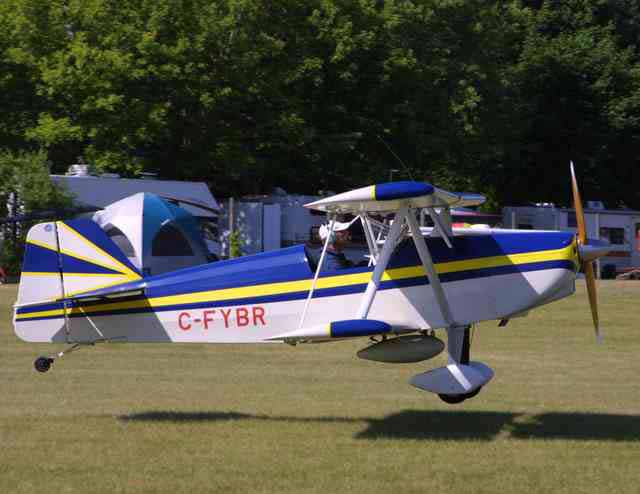Acrolite 1B
ultralight aircraft, Acrolite 1B experimental aircraft, Acrolite 1B experimental light sport aircraft (ELSA), Lightsport Aircraft Pilot News
newsmagazine.
|
Lightsport
Aircraft Pilot is a directory of aircraft that generally fit
into what are described as ultralight aircraft, advanced ultralight
aircraft,
light sport aircraft, experimental light sport aircraft, experimental
aircraft, amateur built aircraft, ELSA or homebuilt
aircraft in the United States and Canada. These include
weight shift aircraft, more commonly known as trikes,
powered parachutes, and powered para-gliders.
|
|
|
|
|
|
|
|
Acrolite 1B ultralight, experimental
lightsport, amateur built aircraft.
|
|
Manufacturer
www.acrolite.org
The Acrolite
was designed as a good performing entry level aerobatic
capable aircraft in a light, low cost package for those
pilots that want a more exciting and challenging aircraft to
fly than the more common type of light and ultralight
aircraft.
Designed by Ron Wilson of Murillo Ontario, it was the winner
of the 1995 Scratch Build Design Contest sponsored by
Aircraft Spruce and Specialty Co. of Fullerton California
and hosted by the Experimental Aircraft Association in
Oshkosh Wisconsin.
This design won out over 102 entries from all over the
world. Aircraft Spruce sponsored the cost of building the
airframe and the aircraft was built in one year by Peter
Eisenbach of Thunder Bay and Vern Ennis and Harold Spithoff
of Kakabeka Falls Ontario. |
|
|
|
It was designed with
strength, ability to take abuse, ease of repair, good short
field performance and stable flight characteristics as the
most important features.
The strut braced staggered wing biplane design affords good
visibility and requires a pilot with only average flying
ability but with some experience in high performance
taildraggers. The design and basic construction is in
accordance with standard aircraft practices and aircraft
grade materials are used throughout. The aircraft is
conservatively stressed for a limit load of 6 G positive and
4 G negative with a 1.5 safety factor at a gross weight of
750 lbs.
One of the nice things about small biplanes is that they can
be built in a fairly small area. The largest piece is the
fuselage which is approximately 12 feet long 2 feet wide and
4 feet high. Built on a 12' x 2' table with a minimum of 3
feet of walk around area it can be built in any 17 foot long
room. A single car garage is more than adequate and the
entire aircraft can be fully assembled in an average 2 car
garage. The wing panels are built standing on edge in a 8
foot long jig.
For the best performance and reliability the preferred
engine is the four cylinder Rotax 912. This is the engine
used in the prototype. However the Rotax 582/618 twin
cylinder two stroke with a "C" or "E" type gear reduction
drive will give good aerobatic performance at a lower cost.
The fuselage is constructed of welded 4130 chrome moly steel
tube. A welded steel fuselage is generally considered to be
the most durable, is easy to repair and provides the best
protection against impact damage. Control linkages to the
ailerons and elevator are push-pull rods with bearings on
each end. Rudder and steerable tailwheel control is via a
common cable. The tail assembly is constructed of 6061
aluminum tube riveted together with 2024-T3 aluminum gusset
plates.
The wing is of stressed skin wood construction with a built
up box section main spar, built up ribs, plywood sheeting
and fabric covered. The builder will also have the option of
building the wing entirely of 2024-T3 aluminum with a box
section main spar, a channel section rear spar, fully
sheeted and flush riveted with 1/8 inch diameter stainless
steel blind rivets. The airfoil is GA30-212 semi-symmetrical
section designed by Harry Ribblett. This airfoil is noted
for its low drag and excellent stall characteristics. The
ailerons are semi-full span aluminum tube, static balanced.
The fuselage, empennage and ailerons are fabric covered with
1.7 oz PolyFiber fabric.
The landing gear is one piece spring aluminum clamped and
bolted directly to the bottom of the fuselage with four
bolts. This type landing gear has low drag is easy to
construct and handles hard landings and rough ground well.
The wheels and tires are 500 X 5 aircraft type with cable
operated drum brakes. Optionally hydraulic operated disk
brakes can also be used. The tailwheel spring is formed from
aluminum flat bar and the tailwheel swivel unit is welded
from chrome moly sheet steel. The 5 inch diameter tail wheel
is molded hi-impact plastic. |
|

Acrolite 1B ultralight -
experimental lightsport aircraft |
|
|
|
|
|
|
Light Sport Aircraft Pilot News Web Magazine.
You may link to these pages or print
them out for your own personal use.
No part of this
publication may be copied or distributed, transmitted, transcribed,
stored in a retrieval system, or translated into any human or computer
language, in any form or by any means, electronic, mechanical,
manual, or otherwise, without the written permission of Light Sport
Aircraft Pilot News.
By copying or paraphrasing the intellectual
property on this site, you're automatically signing a binding contract
and agreeing to be billed $10,000 payable immediately. Copyright Light Sport Aircraft
Pilot News. Email
|
|